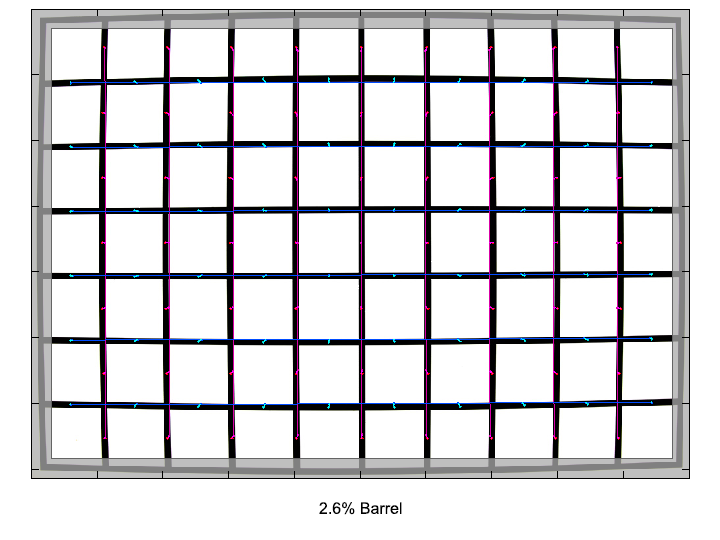|
Page 2 of 3

Distortion
In terms of distortion, the Sigma shows a behaviour typical for most zoom lenses. There is a considerable amount of barrel distortion at the shortest focal length, which decreases by zooming in, until it eventually switches to pincushion type distortion at the opposite end of the zoom range.
|
Move the mouse cursor over the focal length text marks below to observe the respective distortion
|
| 24 mm |
28 mm |
35 mm |
|

|
The chart above has a real-world size of about 120x80cm.
Vignetting
Being such a fast lens, it's hardly surprising that the Sigma shows quite some vignetting wide open. The light fall-off at f/2 is roughly on the same high level of around 1.8 EV throughout the whole zoom range.
As usual, stopping down reduces the amount of vignetting to significantly lower levels. From f/4 onwards, it shouldn't be an issue anymore for most subjects.
We're performing our vignetting analysis based on
(uncorrected) JPEGs straight from the camera. The JPG engine of the Nikon D3x features a rather flat
gradation curve, thus has a moderate contrast characteristic, resulting in comparatively low vignetting figures - the
corresponding Canon figures are roughly 40% higher due to the more
aggressive default contrast setting.

MTF (resolution)
The lens delivers impressive sharpness, especially in the image center, where throughout the whole zoom range the resolution is excellent straight from the largest aperture setting. Stopping down increases these figures even further to a level we rarely see here.
At 24mm and 28mm the borders and corners start a bit softer at f/2, but also reach very high levels when stopped down to medium aperture settings. At f/4 and f/5.6, the lens delivers excellent sharpness across the whole image frame.
At 35mm, image borders and corners don't reach the same high levels anymore, but still show very good sharpness from f/2.8 onwards.
The lens showed a minor amount of focus shift when stopping down.
Please note that the MTF results are not directly comparable across the different systems!
Below is a simplified summary of the formal findings. The chart shows line widths
per picture height (LW/PH) which can be taken as a measure for sharpness.
If you want to know more about the MTF50 figures you may check out the corresponding
Imatest Explanations

Chromatic Aberrations (CAs)
Chromatic aberrations (color shadows at harsh contrast transitions) are very well controlled for a wide angle lens and show fairly moderate values of roughly 0.6 to 0.8 pixels at the image borders throughout the tested zoom and aperture range.

Bokeh
With a maximum aperture of f/2 the Sigma has some potential to separate the main subject from the background, where the quality of the background blur is of importance.
For a wide angle lens, the Sigma delivers surprisingly smooth bokeh. Background highlights show hardly any outlining and are evenly filled, the only issue is a slight amount of bokeh fringing (see next section). In the transition zone, image blur is a tad nervous, but many lenses struggle here and we've seen much worse from other lenses with similar focal lengths.

Bokeh Fringing
Bokeh fringing (non-coinciding focal planes of the various colors) is a common issue with relatively fast glass. As you can notice below the halos have different colors - magenta (red + blue) in front of the focus point and green beyond. Unlike lateral lateral CAs, bokeh fringing can not easily be fixed in post processing.
As most fast lenses, the Sigma shows some bokeh fringing wide open, which can be reduced by stopping down.
In addition, these shots also illustrate the small amount of focus shift already mentioned in the MTF section.
|